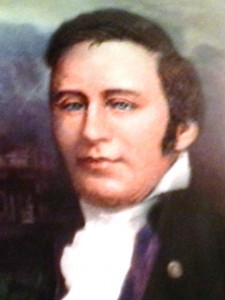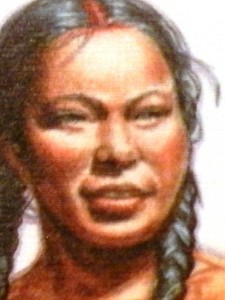» posted on Monday, August 27th, 2012 by Linda Lou Burton
He Called Her Janey
 Linda Burton posting from Bismarck, North Dakota – Is it Sacajawea? Or Sacagawea? I’ve seen it spelled both ways as I have been bumping into Lewis and Clark of late. And now, here in Bismarck, the statue near the capitol honoring the “Bird Woman” has a spelling of “Sakakawea.”(pronounced Sa KAH- kah-we-a.) I was told at the Heritage Center that North Dakota chose this spelling and pronunciation because it more closely matches the Shoshone sound of her name. Yet, when I traveled north to the Lewis & Clark Interpretive Center in Washburn, North Dakota, I found exhibits there use the
Linda Burton posting from Bismarck, North Dakota – Is it Sacajawea? Or Sacagawea? I’ve seen it spelled both ways as I have been bumping into Lewis and Clark of late. And now, here in Bismarck, the statue near the capitol honoring the “Bird Woman” has a spelling of “Sakakawea.”(pronounced Sa KAH- kah-we-a.) I was told at the Heritage Center that North Dakota chose this spelling and pronunciation because it more closely matches the Shoshone sound of her name. Yet, when I traveled north to the Lewis & Clark Interpretive Center in Washburn, North Dakota, I found exhibits there use the  spelling of “Sacagawea.” The Bismarck statue, erected in 1910 by the Federated Clubwomen and the Schoolchildren of North Dakota, bestows great honor on the young woman; the plaque reads: The Shoshone Indian “Bird Woman” who in 1805 guided the Lewis and Clark Expedition from the Missouri River to the Yellowstone. The exhibit in Washburn, just completed this year, grants her a smaller role; presented in terms of “Legend” and “Fact,” it states she was not a guide, but an interpreter; and that William Clark, though fond of her, was not a romantic relationship. But, it is acknowledged, he called her Janey.
spelling of “Sacagawea.” The Bismarck statue, erected in 1910 by the Federated Clubwomen and the Schoolchildren of North Dakota, bestows great honor on the young woman; the plaque reads: The Shoshone Indian “Bird Woman” who in 1805 guided the Lewis and Clark Expedition from the Missouri River to the Yellowstone. The exhibit in Washburn, just completed this year, grants her a smaller role; presented in terms of “Legend” and “Fact,” it states she was not a guide, but an interpreter; and that William Clark, though fond of her, was not a romantic relationship. But, it is acknowledged, he called her Janey.
 The lecturer at Fort Mandan, on the river just north of Washburn where Lewis and Clark spent that first winter, is a big fan of William Clark. “Lewis may have been the official leader of the expedition,” he said, “and he was the one who had the crash course in science before the trip began, but it was Clark who was the people person. He knew how to get the group to work together, to cooperate with one another, and to keep going when things got tough. In my mind he was the real leader.” It was Clark who nicknamed Jean Baptiste Charbonneau “Pomp” and provided him with an education; it was Clark who arranged for land and money for Charbonneau and Sacajawea after the expedition ended.
The lecturer at Fort Mandan, on the river just north of Washburn where Lewis and Clark spent that first winter, is a big fan of William Clark. “Lewis may have been the official leader of the expedition,” he said, “and he was the one who had the crash course in science before the trip began, but it was Clark who was the people person. He knew how to get the group to work together, to cooperate with one another, and to keep going when things got tough. In my mind he was the real leader.” It was Clark who nicknamed Jean Baptiste Charbonneau “Pomp” and provided him with an education; it was Clark who arranged for land and money for Charbonneau and Sacajawea after the expedition ended.
We know that Sacajawea had some tough breaks in life; she was kidnaped and taken from her family at a young age; she was one of several wives of Charbonneau, in truth, he bought her. Was he a kind and loving husband, or a domineering and abusive owner? We don’t know the answer to that; but we do know that she went marching off with a baby on her back at the age  of seventeen; that she endured the hardships of the unknown with a group of men for two years (likely smelly, grumpy and crude at times); and that she received no pay for a single lick of her work. Yet it appears that Clark, the people person, was kind to her son, and to her; I’m glad to learn he called her Janey.
of seventeen; that she endured the hardships of the unknown with a group of men for two years (likely smelly, grumpy and crude at times); and that she received no pay for a single lick of her work. Yet it appears that Clark, the people person, was kind to her son, and to her; I’m glad to learn he called her Janey.
 The statue by the capitol is an impressive sight; she is depicted as a strong and graceful woman, although older than I’d imagine a seventeen-year-old girl would look. The sculptor, Leonard Crunelle, used a model named Hannah Levings, a Hidatsa woman; supposedly a descendant of Sacajawea, although the connection is not explained. Most scholars, relying on Clark’s writing and other evidence, believe Sacajawea died of a fever at Fort Manuel on the Missouri River, just south of the border between North and South Dakota, in December 1812; it is also believed she had a daughter who was killed at an early age. Again, there is more to the legend than can be proven.
The statue by the capitol is an impressive sight; she is depicted as a strong and graceful woman, although older than I’d imagine a seventeen-year-old girl would look. The sculptor, Leonard Crunelle, used a model named Hannah Levings, a Hidatsa woman; supposedly a descendant of Sacajawea, although the connection is not explained. Most scholars, relying on Clark’s writing and other evidence, believe Sacajawea died of a fever at Fort Manuel on the Missouri River, just south of the border between North and South Dakota, in December 1812; it is also believed she had a daughter who was killed at an early age. Again, there is more to the legend than can be proven.
 In my mind she is the American Indian mother who accompanied Lewis and Clark from Mandan to the Pacific Ocean, and back to the Knife River villages, with a baby on her back; young and sometimes smiling; industrious and always courageous. Whether we spell her name Sacajawea, Sacagawea or Sakakawea, just like William Clark, I’ll affectionately, and respectfully, call her Janey.
In my mind she is the American Indian mother who accompanied Lewis and Clark from Mandan to the Pacific Ocean, and back to the Knife River villages, with a baby on her back; young and sometimes smiling; industrious and always courageous. Whether we spell her name Sacajawea, Sacagawea or Sakakawea, just like William Clark, I’ll affectionately, and respectfully, call her Janey.
About the Bismarck Statue http://lewisandclarktrail.com/section2/ndcities/BismarckMandan/sakakaweastatue.htm
About Fort Mandan Foundation and the Lewis and Clark Interpretive Center http://www.fortmandan.com/
A copy of the statue of Sakakawea near the North Dakota capitol represents the state in Statuary Hall in Washington, DC http://www.aoc.gov/cc/art/nsh/sakakawea.cfm
